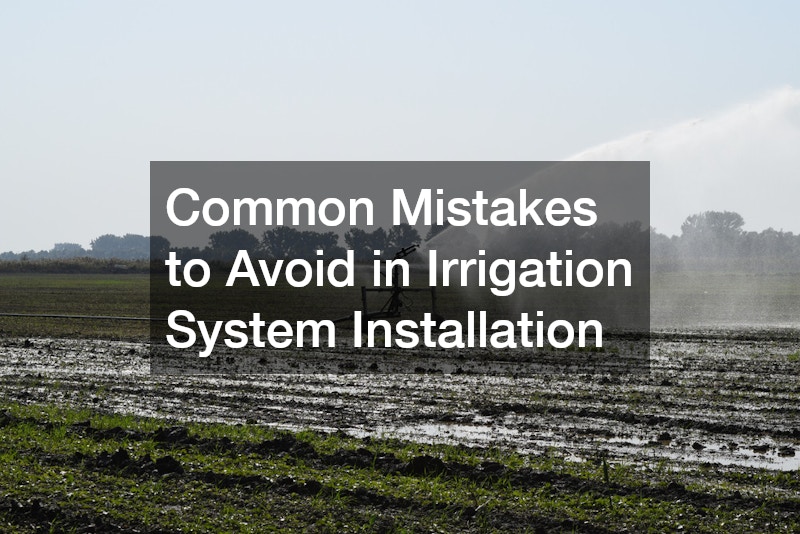Proper irrigation system installation is crucial for maintaining a healthy, thriving lawn or garden while conserving water and minimizing maintenance issues. However, many homeowners and landscapers encounter common pitfalls during the installation process that can lead to uneven watering, costly repairs, or inefficient system performance. This article explores these frequent mistakes in detail and provides practical guidance on how to avoid them, helping you achieve a smooth, successful, and efficient irrigation setup that keeps your plants flourishing year-round.
What are the key factors to consider before installing an irrigation system?
Before installing an irrigation system, it’s crucial to assess the specific needs of your landscape and the environmental conditions. Factors such as soil type, plant types, and local climate play a vital role in determining the suitable irrigation methods.
Additionally, understanding the water source is essential for ensuring sustainable operation.
Another important consideration is the layout of your garden or agricultural space. Analyzing the area will help identify the best spots for placing sprinklers or drip lines, and influence water pressure and flow rates for optimal water distribution. This step is often overlooked, leading to inefficiencies in water usage.
Finally, budget constraints should be carefully evaluated. Selecting the right materials and technology within your budget can significantly impact the long-term effectiveness and maintenance costs of the system. Investing upfront in quality components can save both time and resources in the long run.
How does choosing the wrong irrigation type impact efficiency?
Selecting an inappropriate irrigation system can have far-reaching consequences, leading not only to wasted water but also to unhealthy plants and suboptimal growth. Each type of irrigation system is designed with specific environments and plant needs in mind. For example, drip irrigation is ideal for gardens with plants of varying heights and water requirements, as it delivers water directly to the root zone with minimal evaporation. On the other hand, sprinkler systems are typically better suited for larger, uniform lawns, but they can easily cause overspray, runoff, or uneven coverage if not carefully calibrated.
Using the wrong irrigation type can also place unnecessary strain on your water source, causing pressure drops, uneven flow, or even shortages in more extensive systems. Over time, these inefficiencies can increase maintenance costs and reduce the lifespan of your irrigation components. Choosing the appropriate system ensures that water is applied in the correct amount and at the right locations, promoting healthier plants while conserving this valuable resource.
Efficiency also depends on a thorough understanding of your soil type, sun exposure, plant species, and landscape layout. For example, sandy soils may require more frequent, lighter watering, while clay soils retain moisture longer and benefit from slower, deeper irrigation. By carefully assessing these factors, you can tailor your system to meet the specific needs of your landscape, reducing waste and improving overall performance.
Ultimately, the choice of irrigation system impacts both plant health and resource management. An efficient system saves money on water bills, reduces environmental impact, and creates a more sustainable, low-maintenance landscape. To achieve the best results, it’s wise to consult with irrigation professionals or conduct detailed research to ensure your system aligns with your property’s unique conditions. Proper planning at the outset can prevent costly mistakes and ensure long-term success for your irrigation setup.
What are the consequences of improper system layout and design?
An improper design can lead to uneven water distribution, where some areas may receive too much water while others receive too little. This inconsistency can result in areas of overwatering, causing root rot and attracting pests, while under-watered spots can stress plants and hinder growth.
Additionally, a subpar layout can create a greater need for maintenance. Systems that are poorly designed often face clogging, leaks, and other technical issues due to misplaced components. Regular troubleshooting may be required, consuming time and resources that could have been prevented with careful planning.
Moreover, inefficient layouts can lead to excessive runoff, which contributes to erosion and negatively impacts the surrounding environment. It is essential to take the time to plan an effective system layout, taking into account the specific needs of your landscape and ensuring that all components work harmoniously to deliver optimal water distribution.
Why is regular maintenance vital for irrigation systems?
Regular maintenance is crucial to sustaining the performance of any irrigation system. Over time, components such as filters, emitters, and sprinkler heads can accumulate debris, affecting water flow and distribution. Failing to conduct routine checks can lead to reduced system efficiency and increased water waste.
Moreover, maintaining your irrigation system helps identify and rectify potential problems early on before they escalate into more significant issues. Regular inspections can prevent costly repairs and systemic malfunctions, ensuring that the system operates at its best. This proactive approach often results in longer lifespan and improved reliability of the components.
Routine maintenance also extends the overall lifespan of your irrigation system. By investing time in caring for the system, you can enhance efficiency, protect against unforeseen breakdowns, and ultimately safeguard your investments in plants and landscaping. A well-maintained irrigation setup is not only beneficial for immediate needs but also for long-term sustainability.
By recognizing and addressing these common mistakes, you can enhance the effectiveness and longevity of your irrigation system, leading to better resource management and crop health.
